
|
Delaronde Lake
Excerpts from Timber Trails with additions
Delaronde Lake lies approximately seven miles northeast of Big River. Indians were the first people to inhabit the area surrounding this thirty-five-mile long lake. The lake was first known as Stoney Lake, later changed to Delaronde in honour of Alex Delaronde, a fur trader. Delaronde established a trading post and stopping place at the south end of the lake in the early 1900s. Some of the old trails, made by the Indians, are still discernible. These trails converge on the lake from outlying areas. Some come from as far away as Waskesiu in the Prince Albert National Park. The Indians used these trails to transport their furs to the trading post. Some Indians made their homes near the lake, congregating in an area on the East Side of the lake near Grassy Island. This settlement became known as the Indian Village. An old graveyard attests to the fact that this particular area has long been a favourite camping ground for several generations of Indians. This area has never officially been set aside as an Indian Reserve. White men began coming into the district as early as 1913. One of the firsts to claim homestead rights was a French Canadian by the name of Arelle Morin. During the next few years, several French families moved into the district. These people, wanting to maintain their own customs and language, wished to have a separate school for their children. After waiting an appropriate length of time, and seeing that a school was not forthcoming, they became disillusioned and moved to nearby districts such as Debden, Victoire and Shell River. These areas were more heavily populated with French Canadians, therefore they had a better chance for their voices to be heard. Not all the families moved away, some families preferred to remain in the district. The well-known names of some of these people are Michel, Boisvert, Chenard, Gallant and Caisse. As a consequence of some families moving away, the land they left behind became available. This land was eagerly sought after by other families moving into the district, as the primary work had already been done. In the thirties, a new group of people came into the district as the drought in the southern part of the prairies made it impossible for them to make a living. The Government sanctioned this move and encouraged the people to start a new life in the northern regions where conditions were not so harsh. The Government supported these people in their new endeavour by providing some of the essentials needed such as a team of horses, a cow and some farm implements. These people received little income from their farms, however, supplemented their livelihood by fishing, trapping, bush work or by working in the lumber mills. Before we continue any further let us go back for a moment and take a look at the progressive growth of the settlement before the arrival of these newcomers. The twenties and thirties were boom years for the fishing industry. Thus, fishing and hauling of fish provided work for many local residents. Fish was hauled with horses and sleighs following one behind the other in long processions known as " freight swings." The slow progress of these freight swings made it necessary to have stopping places at frequent intervals along the way where men and horses could stop for rest and food before continuing on their journey. A stopping place located at the south end of the lake could accommodate forty teams of horses. This place was owned by Big River Consolidated Fisheries. The man in charge was Jack Rae. Mr Rae hired a cook to do the cooking and together they ran the place for several years. Mr Rae later married Alma, the cook. Continuing further up the lake the next stopping place was Joe Sheppard's (he was an uncle of Jim Young). Mr Sheppard ran this place alone for several years. Johnny Olsen had a stopping place at the Narrows while a stopping place at the end was owned by Willie Tongue. During this period, small private sawmills began to appear on the scene. George Anderson set up a mill at the landing in 1922. This mill operated continuously until 1947. 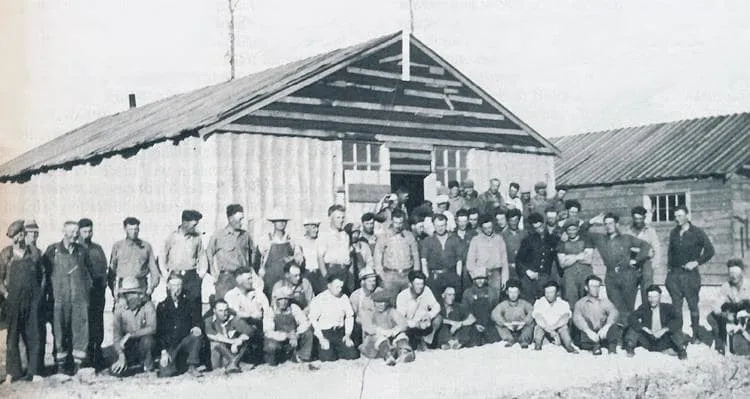
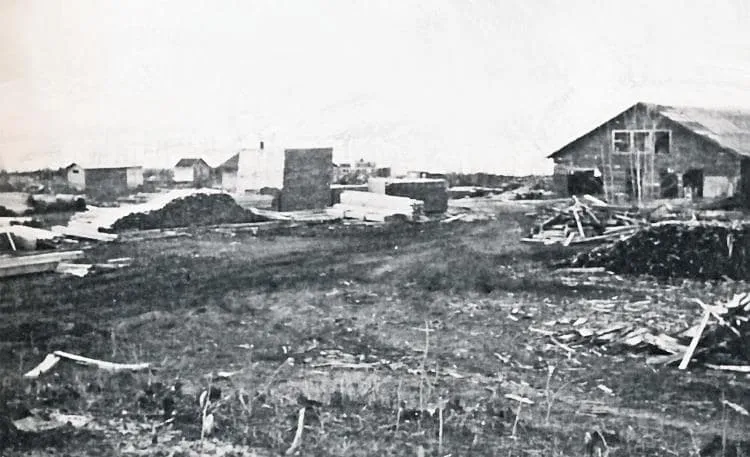
A man by the name of Ellis operated a mill at the north end of Delaronde during the winter of 1936-37. In the spring, he moved the mill to a location south of the landing and sold to Mr Pinkerton and Mr Boyd. The next year Mr Pinkerton left and Mr Boyd ran the mill alone for the next four or five years. Operations were discontinued at this time and the mill was dismantled. An interesting note here about Mr Boyd's mill. A horse-drawn buggy was used to haul the lumber away from the mill. The buggy ran on tracks, this made it easier for one horse to haul heavy loads. The lumber was piled in a slanted position to ensure proper run-off of rain. The mill was run by two steam engines. A third engine was used as a spare, thus greatly reducing costly shutdowns. The south end of the lake seemed to be a favourite place for mills as throughout the succeeding years' several mills dominated this area. Most of the mill sites were situated on the West Side of the lake except for a mill and box factory owned by Mike Thibeault. The mill was situated on the east side of the lake near Grassy Island. Mike ran the mill from 1935 to 1955. Some of the other well-known operators were Mr Rizer, Oscar Eikel and Rider Lomsness, Joe Friedman and Andy Sundby. Small communities soon sprang up around the mill sites. Families lived in temporary homes, mainly cabooses that were once used on the fish hauls or used in lumber camps. These small mills gradually phased out with the advent of a large government mill, which came into production in 1951, in the nearby town of Big River. Mr Sundby's mill continued until the early sixties when its doors were finally closed, bringing to an end of one stage in the development of the district. Old sawdust piles can still be found in the area, mute evidence of a once active enterprise. Mills were already established at the time people started coming in from the prairies in the thirties. Although there were different types of work available to these people, money was in short supply as this was a period of economic depression throughout the country. The Depression, as in other great disasters, tended to bring people closer together. They willingly helped each other when help was needed. They joined together in community activities and always found time to visit a friend. This community spirit sustained them throughout hard times. 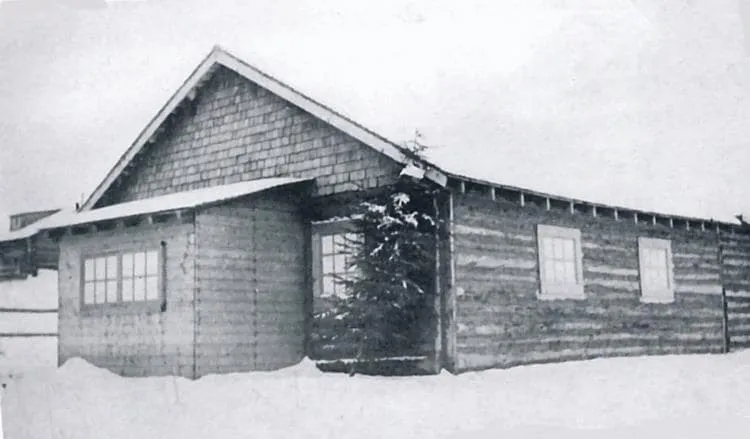
Soon after the arrival of these newcomers, the need for a school became apparent, as there were approximately twenty-seven children of school age. In March 1933, Arvid Erickson wrote a letter to the Minister of Education requesting permission to build a log school in the Delaronde area. Several sites for the school were suggested. After much controversy over location and boundaries, permission to build a school was finally granted. The site chosen by the Department was the SE 4-57-7-W3 Two acres of this land was donated by Sid Holmes. A grant not to exceed two hundred dollars was given by the department to defray the cost of doors, windows and hardware. Mr Bale gave permission for logs to be cut on his land. The building of the school soon got underway with voluntary labour. The school was opened in March 1935 and although it was substantial, the unpainted interior was dark and gloomy. The desks were factory-made. The library consisted of those books provided by the Department. 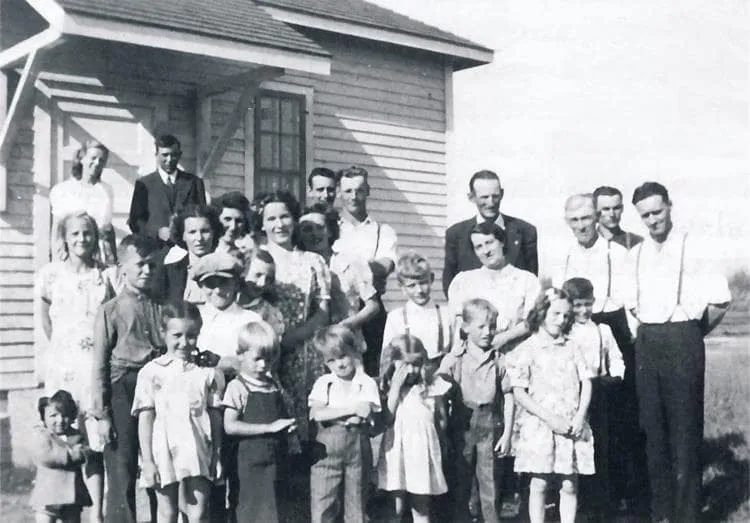
The first teacher was Mrs H. Gran, who stayed until November, at which time Mr Alexander Reed was hired at a monthly salary of thirty dollars. Teachers were hard to secure and rarely stayed more than one term.
The names of teachers from 1935 to 1950 are as follows:
Mr. Reed-1935-1937
Jacob Ulmer-1937-1938 Mr Donahue-1938-1939 Mrs. Blanche McCowan 1938-1939 Mrs. Croteau-1938-1940 Mrs. Nettie Harrower 1940-1942 Mr. Harry Charles Barry 1942-1943 Irene Stein - 1943-1944 Miss Elsie Swales 1944 - 1946. In 1945, an application was made for a grant to build a new school. The school was built with a total expenditure of three thousand and seventy - six dollars. Mr Erwin Lundy was the contractor. Much of the labour was voluntary. Teachers in the new school were the following: Mrs Vera Orange 19461947, Mrs J. M. Sunberg 1947-1948, Mrs C. Dion 1948-1949, Miss Barbara Davidson 1949-1950, Helen Reed 1950-1951. The school inspector was Mr R. H. Ferris. From 1952 onward children were transported by bus to Big River. 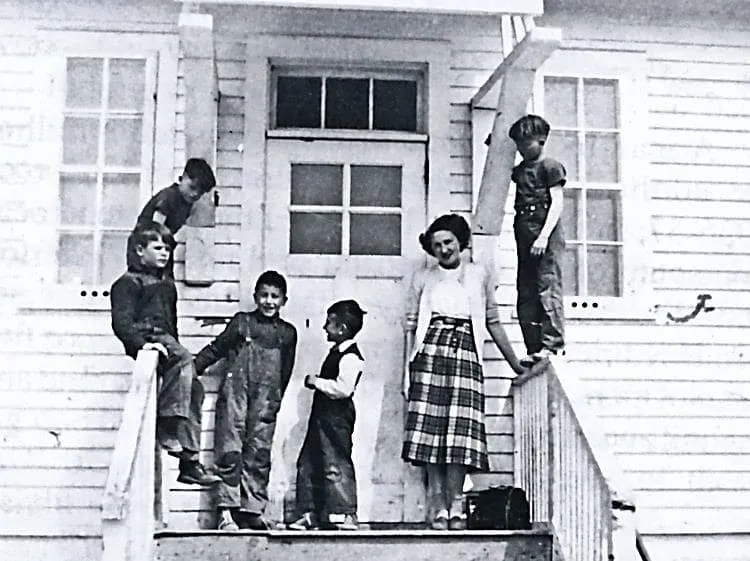
Meanwhile, at the south end of the lake, there were enough children of school age to warrant having a school in that area. They were not so successful in obtaining permission to build a school. For eleven years, there wasn't any school. In 1942, permission to build was finally granted but with most of the able-bodied men away in the service, the building of the school had to be postponed. A hall of log construction, owned by Andrew Millikin, was rented at a rate of fifteen dollars a month. In 1944, a ratepayers meeting was held and it was proposed that they should buy the school from Andrew Millikin for the sum of five hundred dollars. School opened on January 14, 1943. The school district number was 5175. The teacher was Miss M. M. Potie, District administered by R. H. Ferris, an official trustee. Secretary A. Millikin, Treasurer R. H. Ferris. Some of the teachers were; A. M. Schmidt 1944, Miss Doris Hopkins 1946, R. B. Kalthoff and Miss Georgina Elliot 1947, Anthony Zericha 1948, Margaret Cramer 1949-1950. Trustees and officials included A. Pukanski, D. Klassen was chairman, A. Millikin was secretary-treasurer. In 1948, the trustee was Leslie Bovill. Mr Tom Young was the official trustee. The school was open eighty days in the spring and fifty days in the fall, a total of one hundred and thirty days a year. Most of the old-timers who once lived in the district are gone now but many of their descendants still live in the Delaronde district or the town of Big River. The family names of the people who are no longer in the district include; Erickson, Clement, Pellitier, Crouteau, St Jeans, O'Connor, Bovill, Patrick, Lions, Griefenburger, Riley, Huxted, and Hutt. The names of the families who have descendants in the district are as follows: Bradley, Milligan, Roth, Halsall, Scrimshaw, Gallant, Martin, Colby, Thompson, Millikin, Michel, Klassen, Caisie, Dunbar, Swanson, Dunn, Christensen, Nicholson, Thibeault, Sweeney, Leach, Pukanski, Olsen, Chenard, Pister and Schmidt. Today in 1978, Tom Michel has a vacation area at the lake. Cabins and boats are available throughout the tourist season. Edwin Olsen, who has had a mink ranch near the lake for many years, still carries on the business today. Chris Christensen, a fisherman for many years, still makes his home in the district. The last old-time Indian, Joe Smallboy, also lives at the Narrows. Any other comments about these people can be found in the family history section of this book. By 2004, many changes have taken place. Roads that once were narrow rutted, muddy trails are wide, well-maintained gravel roads leading to all parts of the district. New settlements have been developed along the shores of this fine lake. People from the south ventured north in search of rest and relaxation at our resorts at Pickeral Point, Delaronde Resort, Phillips Beach, Delaronde Estates, many of these people have bought property around the district and have become permanent residents. With the logging operations of Sask. Forest Products and Weyerhaeuser many new roads have opened the eastern side of the lake allowing access to Ness, Nesslin, Hackett, Top, for great fishing. Over the years more land has been opened up for farming. There are several large grain and cattle operations in the district. Some of the present residents of the district are Thiessen's, Halsall's, Andersons, Bradleys, Moules, Millers, Browns, Martins, Lairds, McGraths, Pisters, Doucettes, Blocks, Klassens, Christensens, Hoistingtons, Wilsons, Morin, Olsens, Dunns, Michels, Dysart's, Quirings, and Fleury's. Greenmantle
Excerpts from Timber Trails with additions
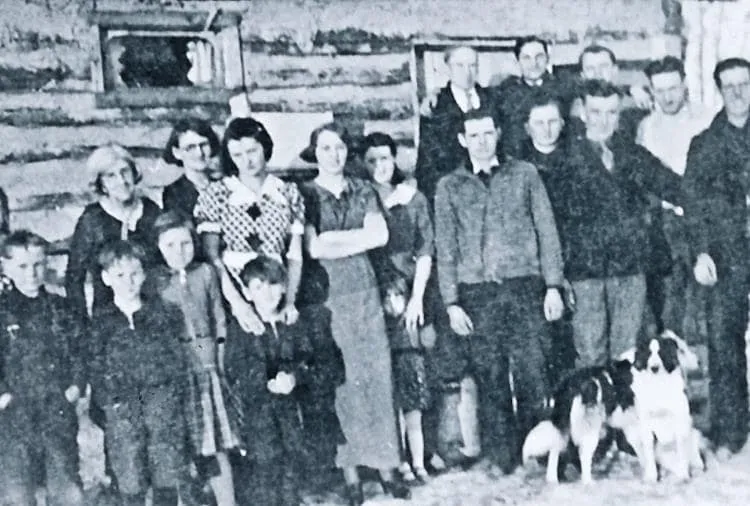
Back Row: Doris Reilly (Sandry), Martha Reed (Reilly), Olive Burt (Reed), Ella Reilly (Leach), Martha Cook (Cronk), Sam Reed, Steve Kereluk, Harry Shinkaruk, Mike Skopyk. Front Row: Earl (Bill) Reilly, Lawrence Burt, Donna Burt, Murray Burt, Ethel Webster (Friesen), Bill Shinkaruk, Roland Burt, Oscar Reed, George Cook. Greenmantle is the farming community south-west of Big River, west of Bodmin, and east of Timberlost. No one seems to know when this district was first settled, but as early as 1931, some families moved into this area they being the Reeds and the Reillys. A family named Cronks owned a dog team, and later hauled wood to Bodmin with a horse and bull team, and later on again, Mr Reilly and a Mr Atkinson each owned a team of oxen. Some of the families living in this area in the early days were: Ivan Leach, Watsons, Cooks, Burts, Skopyks, Shinkaruks, Boychuk's, Ragowskis, who came from either Blaine Lake or Marcelin, Hansons, Websters, McConkeys, Vermette's, La Fontaines, Pembruns, Rodrick Ormand, Steve Kereluk, Cornwaites, Days, Chubs (he was a shoemaker), and John Coughlin, John and Jim Sandry, Mel Alcocks, Peter Olenchuks (who moved in from Timberlost where they had been homesteading; they are now retired and live in Big River and Peter Olenchuk Junior has taken over the family farm), Stub Andersons, Laplante's, the Farming in the Greenmantle area is much the same as West Cowan. Farmers seem to keep lots of cattle to compensate for the loss of grain growing, due to earlier than usual frosts or land being dried out or the reverse, rained out. Mike Skopyk was the first in this district to own a car, a Model T Ford. 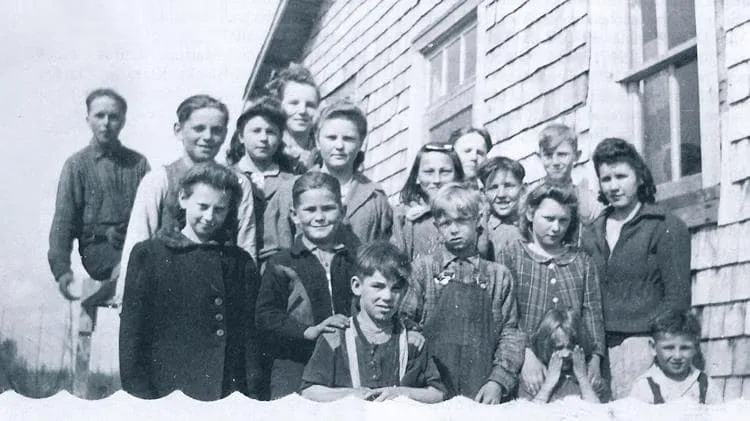
Back Row: Earl (Bill) Reilly, Donna Alexandra Skopyk, Murial Shinkaruk, Flora Tremoine, Murray Johnnie Shinkaruk, Norman Cronk. Front Row: Alvin Cronk, late John Beebe, Clarence Beebe, Jim Delere, Albert Neilson, John Claire, Louis Cronk, Elmer Cronk. Greenmantle was a school district in 1939. The entry in their minute book reads: "Notice is hereby given in the Saskatchewan Gazette May 15th, 1939, that Greenmantle school district No. 5157, has been erected." At that time, Mike Skopyk was board chairman and the late Mr Roland Burt was the secretary. Not too many residents seemed to attend the meeting. One must suppose, with no rural telephones as yet installed, it was hard to notify all the area residents concerned. 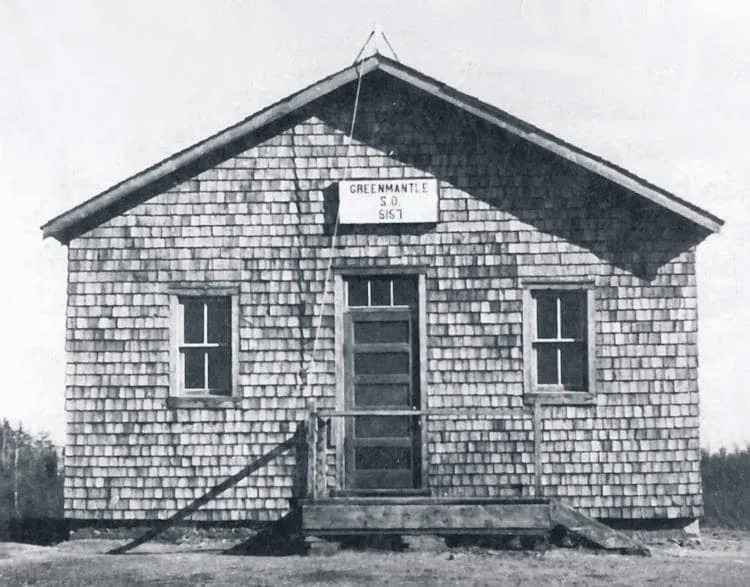
Some of the former teachers were: Mrs. Zunti, Herdman, Barnscott, Chalifour, Mary Gerow and Mrs. Burt. About the year 1953, Greenmantle School was closed and all the children were bused into Big River schools. A few years later, 1957 to be exact, Greenmantle School building with its many memories as the 'little old schoolhouse' was sold to the Evangelical Church board of Big River, and moved into Big River, and has stood since then on the corner of Second Avenue and Highway and 1st street North. The first couple to be married in the new church was Tom and Lorraine Miller (Carter) who were married there on August 1, 1958. 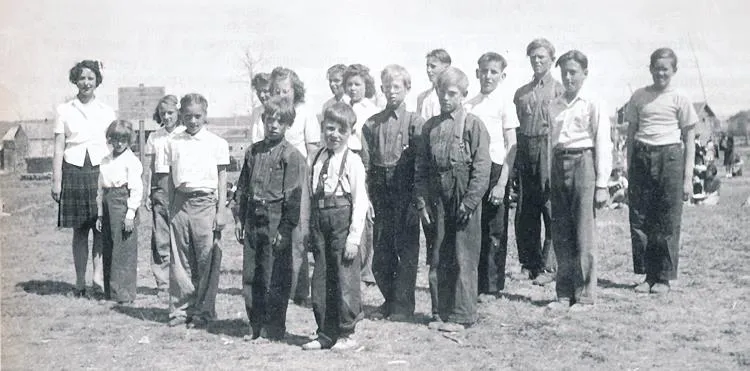
Back Row: Helen Neale (Reed). Third Row: Jean Rogowski, Nick Rogowski, Lawrence Burt, Murray Burt, Albert Cronk. Second Row: Shirley Watson, Ethel Webster, Alexandra Skopyk, Norman Cronk, Eddie Cronk Front Row: Minota Webster, Audrey Watson, Alvin Cronk, Neil Burt. Two people on the far right unknown, May 24th, 1946. After the closure of the Greenmantle School, students were bused to Big River. The first bus driver was Mr M.E. Cronk. In the early 1970s, the Greenmantle bus route would amalgamate with the West Cowan Bus route with Lloyd Gerow as the operator. Others who have driven the bus include: Harold and Shirley Modine, Mr. Jeagers, Harry Beebe and present day owner/operator Holly Reimer. With the students being bused to Big River, the Rural School District of Greenmantle #5157 was disolved. Trustees at this time were James Sandry, Nora Beebe and Margaret Olenchuk. Margaret was a trustee on the Big River local school board till 1988. Residents of Greenmantle district: Irvine Cronk, Ivan Leach family, the Reed family, Reilly family, Watson, Cook, Elmer Cronk, Jim Delere, Burt family, Atkinsons, Skopyks, John Sandrys, Chubs, Shinkaruk family, Boychuks, Rowgowski, Hansons, Webster family, McConkey, John Coughlin, Vermette family, LaFontaines, Pembrun, Roderick Omand, Steve Kereluk, Cornwaites, Days, John Claire, Albert Neilson, John Beebe family, Clarence and Vivian Beebe, Earl and Shirley Beebe and family, Peter and Madge Olenchuk and family, Roy and Shirley Sharp and family, Mrs. Clara Gagne, Russell and Pat Beebe, Buster and Holly Reimer, Connie Bernett and Randy Silk. Other familiar names to the area are, Mrs. Clara Anderson, Henry Anderson, now living in Big River, Lou and Edna Normandeau, Cecile and Tammy Grassick, Earl and Cec Gunderson, George and Doris Serzisko, Heinz and Selke Serzisko, Bill Hurd, Jack Riemer, Bill Lowe, Earl and Shirley Beebe, (Earl Beebe Trucking). Lost and Found
Mrs. Clara Anderson, age 78 years, of the Greenmantle area, was lost over night. Labour Day weekend. September 4th and 5th, 1977 was a weekend Mrs. Anderson remembered for the rest of her life. Sunday started out pleasant enough, so a trip to the block for blueberries and cranberries was the order of the day. By mid -afternoon clouds had moved in and Mrs. Anderson became disorientated and wandered away from the road, instead of towards it. Neighbours, friends and the RCMP were soon looking for her, a tracking dog was soon brought in from Prince Akbert. The search was called off around midnight, to resume again the next morning. A search plane was called in. Around noon she was sighted waving her sweater. The ground search crew along with the dog were soon there and led her to safety. After a cold, wet night in the bush, Mrs Anderson had only a few bruises from her ordeal. Mrs Anderson passed away in January of 1991 at the age of ninety-two years. Ladder Lake and Air Base
Excerpts from Timber Trails
As increased expansion created thriving new communities in the dense northern forests; the need for fire protection arose. This massive timber area was in constant threat of a fire outbreak. The settlers were eager to develop a secure means of fire protection, as the only equipment available was unsuitable for the enormous hazard involved. When a fire started, the fighters were transported by horse and wagon or crude private planes into the burning area. This was a slow process and it often became dangerous. As the era of mechanization developed, aeroplanes were improved to meet the special requirements, such as scanning for forest fires and making long journeys northward. These new demands put a strain on the few private pilots as the heavy workload kept them in continuous operation. The need for an airbase was obvious. Many northern communities began to search for an area that could easily support an aircraft base. In 1925, Ladder Lake less than one mile from Big River was chosen for the location of the new Royal Canadian Air Force Base. The three-mile-long lake supplied the aircraft with an adequate runway for taking off and landing. The base was used to train students to become pilots, to spot forest fires, and to take aerial pictures for map purposes. Everything suitable for scientific fire protection could be obtained close at hand; for within one hour, men, tools and supplies could be boarded on a plane. After the planes were airborne, Cowan and Stoney Lakes were visible and with an increase in altitude, Meadow Lake and Sled Lake could be distinguished. Some of the planes used at that time were referred to as "flying boats". Most of the planes were the regular type being both equipped to land on the water during the summer, or ski-equipped to land on ice and snow during the winter. The Base was equipped with twenty - two Vicker Vedettes, a Fairchild, a Vancouver Flying Boat, a DeHavilland and some Varunas, which were a Canadian designed fire-fighting aircraft. One design situated the propeller behind the pilot. 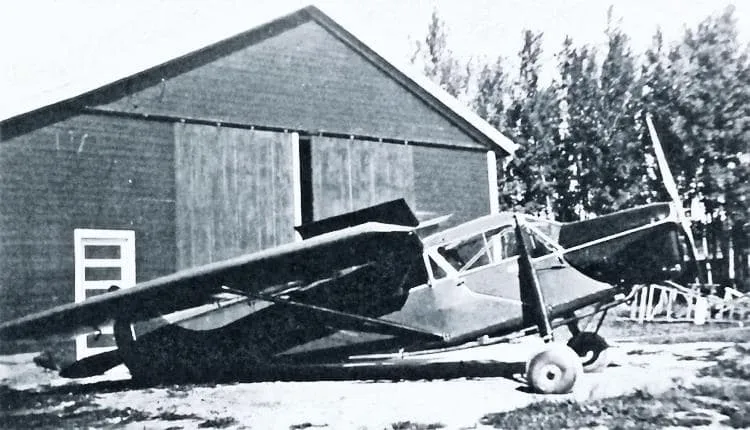
While the base was in operation, RCAF planes were always available for any emergency in the North. During the early years, flying was often a dangerous operation. In June of 1936, while on a patrol flight from the north end of Delaronde Lake to Big River, a plane became trapped in a violent storm. The aircraft, forced to the ground, crashed in the bush about eight miles north of the Narrows. The pilot, Mr Upson, managed to jump and landed in the bush by parachute. The lone passenger, Mr Phillipe Clement, was killed in the wreckage. The crash started a forest fire that destroyed a considerable amount of timber in the area. This tragic event was the only major accident reported at the base. The Air Base buildings consisted of two bunkhouses, a workshop, a tractor and car shed, a radio building, oil sheds a mess hall, an icehouse, a bathhouse and a pigeon house. The pigeon loft was constructed at the base to accommodate the birds used as emergency message carriers. Many of the original aircraft were not equipped with radio communication. When these planes left on a flight, homing pigeons were taken along to be used if an emergency arose. These birds are believed to have originated from the loft of King George V of England. Mr Glen Smith was caretaker of the pigeons at the base. For several years, the Air Base at Ladder Lake was an extremely busy place. However, in 1935, after training numerous students to become qualified pilots, the base closed. Tenders for the sale of equipment was posted in 1936 and one year later the flying supplies were sold to Mason and Campbell Aviation Company and later it was resold to McNeil Airways. After the base was abandoned, two flying boats were sold to the Provincial Government for the sum of one dollar each. Some of the actual buildings from the base were used in Big River. The old mess hall became the Red Cross Outpost Hospital and two more buildings were renovated and used as residential homes. Some of the Air Force officers employed at the base were the following: Mr Apps, Mr Carter, Mr Eddy, Mr Elliot, Mr Lane "Wiggie" Grace, Mr Moore, and Mr Upson. The Base itself became a relief camp. This camp operated in the summer months and Mr Ernie Over of the D.N.R. was in charge of the property. This unemployment relief camp was used to house single men who were clearing 100 hundred acres of land for an airstrip. All work was done by hand and the men received five dollars a month plus room and board for their labours. The project was never completed. The land they managed to clear is used as the present-day golf course. A small canteen was set up for workers at the relief camp, which sold basic commodities at cost price to the workers. In the early thirties, Ladder Lake supported a prominent resort area. The large lake and sandy beaches became a popular swimming spot, which many citizens enjoyed. Cottages were erected on the lakefront and Ladder Lake soon became a thriving tourist community. Some of the regular visitors who built cabins and traveled to Big River each year included the owners of radio station C.F.Q.C., Mr., A.A. Murphy and family, (they installed their own tennis court at the cabin), Dr. and Mrs. Murray and family (Dr Murray was President of the University of Saskatchewan at that time), Mr. and Mrs. Dougherty, Dr. Boyce, Mr. and Mrs. Russel Hartney and family, Mrs. Raymond, Mrs. Stone, Mrs. Cruise, Mrs. Fuller and family, Dr. Bishop, Mrs. Helen Cannon, Mr. McIsaac, Mr. Lucier and family, Mrs. Ernest Linder, Mr. and Mrs. McDonalds and Rhoda, Dr. McKay with his two daughters, Jessie and Jean, and Elizabeth Lang. The tourist population created an active summer resort and events like swimming, fishing and boating were enjoyed by all. 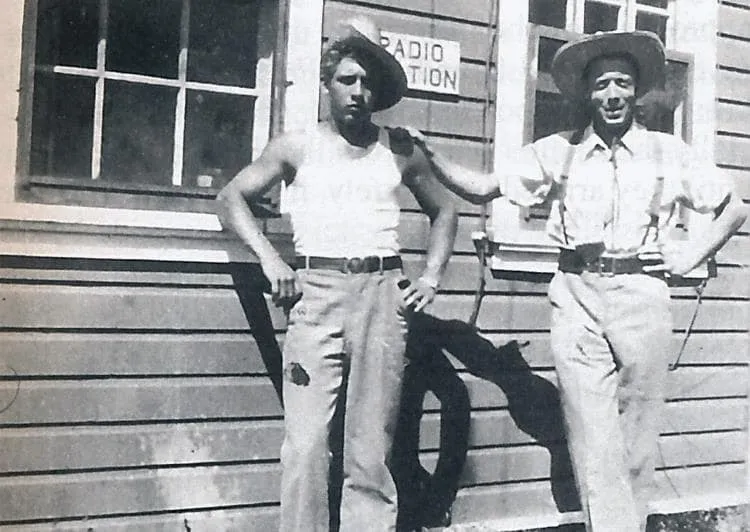
Some families established permanent homes on the lakeshores as well. Several of these families are listed as follows: Mr. and Mrs. Bruce McTaggart, Mr. and Mrs. Casler, The Garneau family, Mr. and Mrs. Crow, Carl Swanson and family, Mr. and Mrs. Jack Schlitz, Lyman Johnstone, Carl Sprecker, the McInnis family, Ernie and Hazel Over, Mr. Ernest Brownfield, Mr. and Mrs. Wilde, Mr. and Mrs. Les McMahon, Mrs. Marianna Goliath. Other families had small cottages and farms across the lake. Some of these included the following ing: Howard and Bill Martin, Denis Malone, Alonzo Chamberland, Paul Papsadorf, Jed O'Donovan, Mr. and Mrs. Clarkson and daughter Rena, Sam Karloff, Martin Gorril, Wilfred Morin, Harry Pryma, Oliver Stein, the Parks, Fredrickson family, Carl Larson, Mr. and Mrs. Dumaresq and family, Mr. and Mrs. Glendenning and family, Mr. Wall, McKnight family, Sam and Anne Olson and Mr. and Mrs. Knight and family. For many years an old scow or barge was used for entertainment as a floating dance hall on the lake. Guests would board the scow, along with the band and refreshments, and then be floated to the middle of Ladder Lake where a dance was held. The scow held approximately fifty people. Dances would commence early in the evenings and continue until late at night. The floating dance hall was built of lumber and had screen windows partway up the walls. This ensured a fresh supply of country air and also provided a means of protection from mosquitoes. Mr Ernest Gamache and later Pete Bouchard were in charge of the scow while entertainment was supplied by local participants. At one time, Ladder Lake and the lake behind Charlie Scrimshaw's country home was much higher and these two lakes were connected by a fair-sized creek. A bridge was built spanning this creek on the Stoney Lake road. It was constructed near to where the 'Duck Pond' is today. Old-timers remember it as a fairly large bridge and was much in use. The water level was much higher at this time and Gaudoise Tremblay recalls the time he and his father journeyed by canoe from Harry Gilbert's farm in Ladder Valley, through the Ladder Lakes and from there right up to Ile-a-la-Crosse, a continuous water route. Ladder Lake flourished as a resort area, enjoying very prosperous seasons with many visitors and campers during the warm summer months. Over the years the water level of the lake has slowly diminished until it has finally lost its appeal as a resort area. The fish in the lake have died from lack of oxygen and the streams that once flowed into the lake keeping it healthy, have now dried up. The result is that today, the Ladder Lake community is considerably smaller in population and size. This is undoubtedly due to the continuous deterioration of the lake. |
| Ausland Lake |
Northern Saskatchewan
| Deep River Fur Farm |
| Deep River Trapping Page |
| Deep River Fishing Page |
| My Norwegian Roots |
| Early Mink of People Canada |
E. Rendle Bowness
| The Manager's Tale |
Hugh McKay Ross
| Sakitawak Bi-Centennial |
200 Year History.
| Lost Land of the Caribou |
Ed Theriau
| A History of Buffalo Narrows |
| Hugh (Lefty) McLeod |
Bush Pilot
| George Greening |
Bush Pilot
| Timber Trails |
A History of Big River
| Joe Anstett, Trapper |
| Bill Windrum, Bush Pilot |
| Face the North Wind |
By Art Karas
| North to Cree Lake |
By Art Karas
| Look at the Past |
A History Dore Lake
| George Abbott |
A Family History
| These Are The Prairies |
| William A. A. Jay, Trapper |
| John Hedlund, Trapper |
| Deep River Photo Gallery |
| Cyril Mahoney, Trapper |
| Saskatchewan |
A Pictorial History
| Who's Who in furs |
1952 to 1956
| A Century in the Making |
A Big River History
| Wings Beyond Road's End |
| The Northern Trapper, 1923 |
| My Various Links Page |
| Ron Clancy, Author |
| Roman Catholic Church |
A History from 1849
| Frontier Characters - Ron Clancy |
| Northern Trader - Ron Clancy |
| Various Deep River Videos |
| How the Indians Used the Birch |
| The Death of Albert Johnson |
| A Mink and Fish Story |
Buffalo Narrows
| Gold and Other Stories |
Berry Richards

